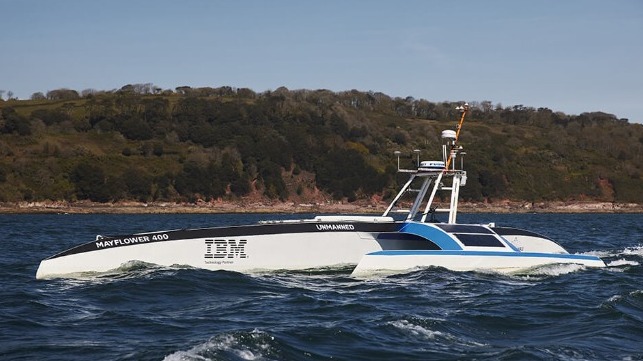Updated: Mayflower Autonomous Ship to Resume Trip After Brief Problem

At nearly the halfway point on its second attempt to become the largest unmanned vessel to navigate across the Atlantic, the Mayflower Autonomous Ship (MAS400) was forced to divert due to a mechanical problem on board. The engineers monitoring the voyage reported that after bringing the vessel into the Azores to diagnose the problem, that it was a failed “isolation switch” which is not critical to the autonomous systems. The voyage will be able to resume.
Having departed from Plymouth in the UK on April 27, the vessel was well underway on its more than 3,000-mile journey, which will take it to Virginia and then on to Washington D.C. They projected that the voyage will take approximately three weeks. The last online report on May 2 showed the vessel had covered over 1,300 miles completing 20 percent of the voyage without a problem.
Promare, which is leading the project, reported that an issue was identified on May 6, which they suspected was related to the vessel’s generator. While announcing that they were suspending the trip due to the mechanical issue, the team highlighted that the sensors, cameras, and AI system were all functioning. The project team did not provide additional details on the nature of the problem, but observers noted that power levels had been dropping as displayed on the online dashboard. The Mayflower is powered by solar panels and batteries and the last report showed that the batteries had dropped to 42 percent of power.
Late today, May 12, Promare issued a further update saying the Mayflower had arrived in the Azores and after running tests the engineers identified the issue as an isolation switch that failed but it is not essential for the autonomous operation. The team has run tests, and re-fueled. As soon as some bad weather in the area passes, the trip will resume.
MAS is now in the Azores. The project lead, Promare, has identified the issue as a switch that failed. It is not essential for autonomous operation. The team has run tests, re-fuelled and are waiting for a bad weather system to pass the Azores before MAS resumes its voyage.
— AI Captain - Mayflower Autonomous Ship (@AI_Mayflower) May 12, 2022
A mechanical issue doomed the first attempt to cross the Atlantic in June 2021. The Mayflower had completed 11 percent of its crossing on the first trip when three days out power levels and speed fell. The team feared the vessel would not have sufficient power to make the crossing and aborted the journey. After bringing the vessel back to England, the team determined that a mechanical issue caused by a fracture in the flexible metal coupling between the ship’s generator and exhaust system caused the loss of power. A metal component had fractured causing diesel fuel to leak leaving the Mayflower without its diesel power which is used as a backup.
With no human captain or onboard crew, the research vessel uses AI and solar energy to make the journey. Measuring 50 feet in length and weighing five tons, the craft was developed at a cost of more than $1 million in a research partnership involving the University of Plymouth, IBM, autonomous vessel specialists MSubs, and charity ProMare. Taking more than four years to develop, the goal of the project is to collect ocean research data during the crossing and demonstrate the emerging capabilities of AI to navigate vessels.
In addition to repairing the coupling that caused last year’s mechanical failure, the team reported that they had taken the time to strengthen components on the ship and enhance the AI systems. The Mayflower is currently in the harbor at Horta in the Azores but should be resuming its voyage shortly heading due west towards the United States. Observers can follow the progress with an online dashboard and periodic updates on social media.
